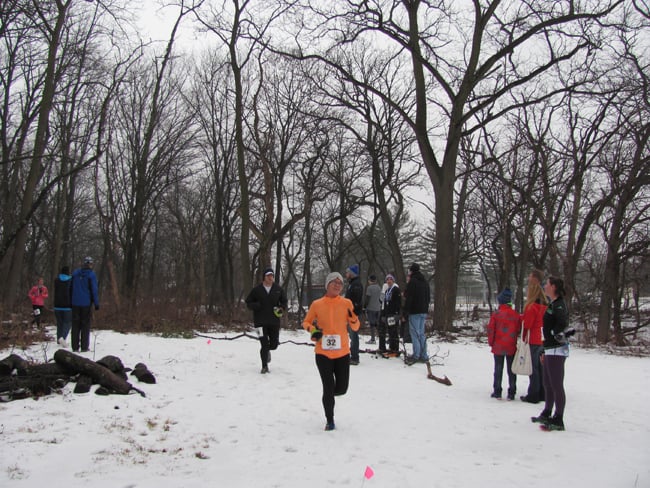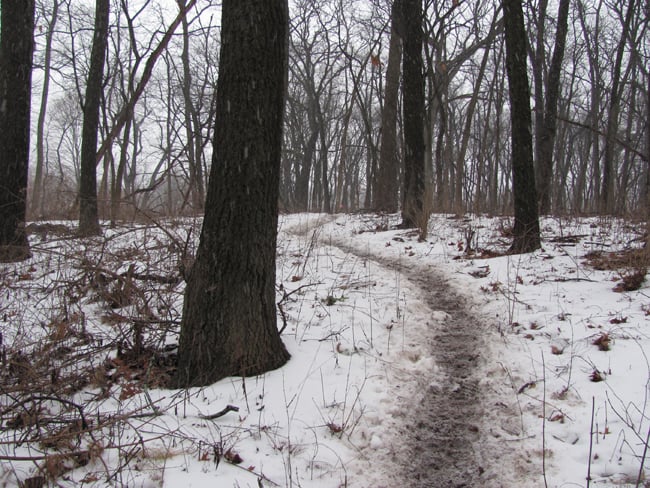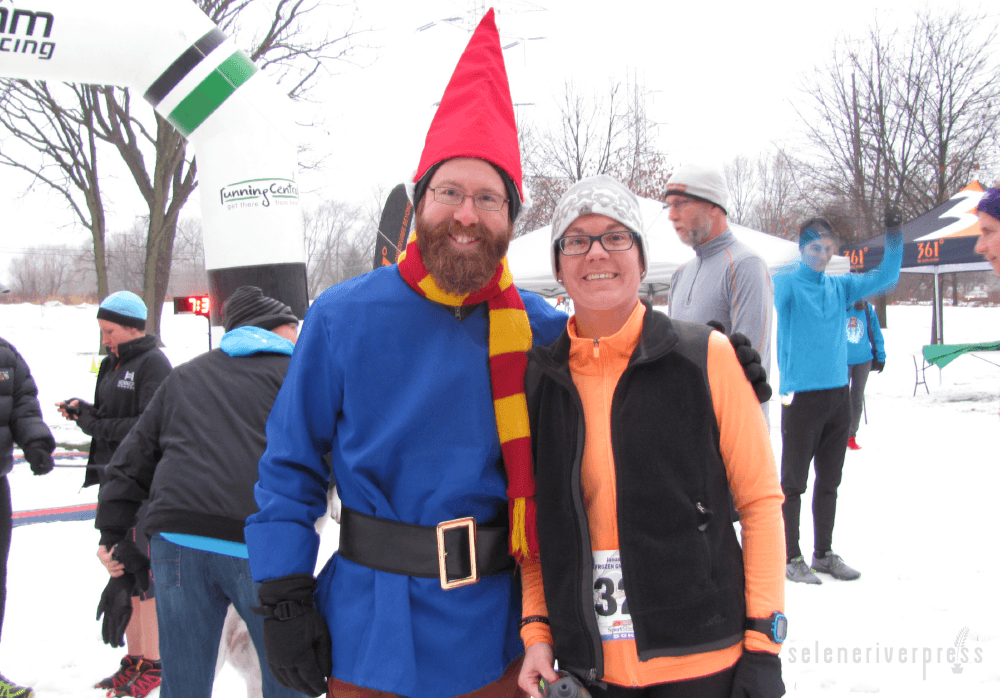I ran and completed my first 50k trail race on January 9, 2016. The Frozen Gnome 10k/50k was held in Crystal Lake, IL, near Chicago. I found the race in the fall of 2015 while reading a Runner’s World magazine highlighted with peculiar race names—and I decided this was the 50k for me. I’m 38 years old, 130 pounds, and 5-feet, 5-inches tall.
I started training for the race in November after my last race of 2015, the Beer and Bagel Squatchy Challenge (1/2ish marathon on Saturday and 4ish mile race on Sunday). I ran 12–15 races last year with a mix of 5k, 10k, 10 mile, 15k, and a few half marathons along with the Market-to-Market (Nebraska) race.
With less than three months to train for the 50k, I scheduled my runs, nutrition, and fuel to best prepare for the race. I read that if you can run 80 percent of the ultra marathon race, then you’re prepared to compete. Since I had a base, I knew that a long run of 25 miles was the goal to train toward. Each week I extended my Saturday morning run until I hit 25 miles, and then, with four weeks till the 50k race, I started to taper. My long runs mimicked the race, which was five 10k loops. I used a local park and the City of Lincoln trails system for training.
 I discussed the race with my dad, Dr. Michael Dority. He suggested adding Cataplex E2 and Cardio-Plus to my daily vitamins. I’ve been taking Standard Process supplements for more than 15 years, so my base is strong. It includes Calcium Lactate, Tuna Oil, and Cataplex A-C-P. I also add two droppers of SP Phosfood Liquid to my glass water bottle each morning. I use the same mixture in my water bottle during long runs.
I discussed the race with my dad, Dr. Michael Dority. He suggested adding Cataplex E2 and Cardio-Plus to my daily vitamins. I’ve been taking Standard Process supplements for more than 15 years, so my base is strong. It includes Calcium Lactate, Tuna Oil, and Cataplex A-C-P. I also add two droppers of SP Phosfood Liquid to my glass water bottle each morning. I use the same mixture in my water bottle during long runs.
I supplemented my caloric intake with SP protein bars and chemical-free protein shakes. The StandardBars in Cocoa Cherry were a good addition to my diet. I drank a protein shake after each run (banana, oranges, organic vanilla or honey, water, and three scoops of SP Whey Protein Powder). My diet is high in protein from good fats (eggs, cheese, red meat, butter), along with my squirrel diet of fruit, veggies, and nuts. I value sleep, getting an average of seven hours each night.
Three days a week I do strength training, including Pilates, yoga, free weights, and kettle bell exercises. I’ve built strength into my weekly calendar for about 10 years now, prior to that it was lifting in high school and college. I walk 30 minutes each day during my lunch break; this is an easy way to add exercise to my day. Most importantly, it gets me out of the building for some fresh air! My running schedule is three days a week: Wednesday (5–8 miles), Saturday (long run), and Sunday (5 miles). Each time I saw my parents, I got a chiropractic adjustment.
Finally, Frozen Gnome began. The 50k race was an awesome experience, the course was beautiful, the volunteers friendly, and the support top-notch. My parents crewed for me during the race, providing water, food, and encouragement every time I came through the aid station. As this was my first ultra marathon, I didn’t know what to expect but did my best to prepare for the weather, trail conditions, fuel consumption, and general race needs.
The one thing I wasn’t expecting were the slushy trail conditions! The winter weather in the Chicago area is snow and cold temps—the usual conditions for the upper Midwest. The temperature rose the day before the race, melting the snow into wet slush before the event. While the warmer weather (36°F) was appreciated, the trail conditions were less than ideal. The only way to describe the trail is to say it was like running 31 miles on sand.
 The course was a 10k loop through a large park; we ran this five times to complete the 50k race. The single-track trail took runners through a forest, across creeks, up and down hills, and over some technical landscape, where the runner must navigate trees, hills, or dips. A few sections included steep climbs, icy patches, and downed trees—it was a beautiful place for a race.
The course was a 10k loop through a large park; we ran this five times to complete the 50k race. The single-track trail took runners through a forest, across creeks, up and down hills, and over some technical landscape, where the runner must navigate trees, hills, or dips. A few sections included steep climbs, icy patches, and downed trees—it was a beautiful place for a race.
My first few loops were good, though I struggled with the trail conditions and fueling. I found the soup in the aid station warm and nourishing, and it helped replenish my salt levels. At some point my competitive nature really kicked in, not to win but to finish strong—and to complete my first 50k race. I wasn’t going to quit due to weather conditions (the temperature dropped and it started to snow) or the slushy trails, and I wasn’t going to be discouraged by the veteran runners dropping out. Several volunteers suggested I was slightly mad for running a black diamond trail run for my first 50k, but I think it was stubbornness and the personal drive to succeed.
I had high hopes of a podium finish in my age group and finishing the race in 6 or 6½ hours. While I didn’t hit either of these goals, I did finish. And I want to run another 50k! Initially, 125 runners registered for the race, but only 67 runners finished. I came in 43rd overall. I was the 9th out of 16 females and the 6th out of 9 runners in my age group (30–39). My time was 7:26:03.
Click here for complete race results for this year, past runs, and race information.
My recovery period was brief. I ran the Wednesday after the race, ate lots of protein, and got plenty of sleep. The nutrition, adjustments, and fuel definitely aided my recovery from the event—just as it did in preparing for it. Since then I’ve run a 5k-trail race, and I’m preparing for a 10k race in early April. I’ll continue to train as I did the 50k; I have several half marathons and two Market-to-Market races later this year. I’ll definitely run another 50k, and I’m considering a 50-mile race in a year or two.
Photos copyright Marcia Dority Baker




